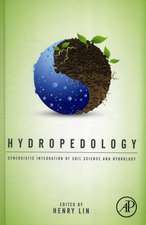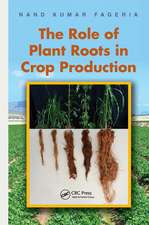Ethnoveterinary Botanical Medicine: Herbal Medicines for Animal Health
Editat de David R. Katerere, Dibungi Lusebaen Limba Engleză Hardback – 23 iun 2010
This book features a multidisciplinary approach to examining the role of herbal medicines in companion and domestic animals and the scientific underpinnings of ethnoveterinary practice. The text also covers matters relating to access benefit sharing, the Convention on Biological Diversity (CBD), intellectual property, and the skills required to navigate the minefield of bioprospecting. The editors have collated information not often found in the English literature from China, Southeast Asia, francophone Africa and South America. They also explore the emerging use of herbals for pets with a case study from the European Union, highlighting this important area which will spur the growth in ethnoveterinary research due to its commercial potential.
Although many references cover ethnoveterinary medicine in some form or another, none give it the intense scrutiny and scientific input found in this book. With chapters on biological assays, efficacy testing, and phytochemistry, the book presents hard scientific information in accessible and readable language. The editors have gathered a panel of veterinary clinicians, animal scientists, pharmacists, chemists and ethnobotanists who have years of experience working with farmers and pastoralists, making this book quite possibly the first detailed compendium on the plants used in animal health care in all regions of the world.
Preț: 1345.67 lei
Preț vechi: 1641.07 lei
-18% Nou
Puncte Express: 2019
Preț estimativ în valută:
257.48€ • 268.86$ • 212.63£
257.48€ • 268.86$ • 212.63£
Carte tipărită la comandă
Livrare economică 15-29 aprilie
Preluare comenzi: 021 569.72.76
Specificații
ISBN-13: 9781420045604
ISBN-10: 1420045601
Pagini: 450
Ilustrații: 34 b/w images and 50 tables
Dimensiuni: 156 x 234 x 28 mm
Greutate: 0.99 kg
Ediția:1
Editura: CRC Press
Colecția CRC Press
ISBN-10: 1420045601
Pagini: 450
Ilustrații: 34 b/w images and 50 tables
Dimensiuni: 156 x 234 x 28 mm
Greutate: 0.99 kg
Ediția:1
Editura: CRC Press
Colecția CRC Press
Public țintă
ProfessionalCuprins
Methods for Evaluating Efficacy of Ethnoveterinary Medicinal Plants. Logistical and Legal Considerations in Ethnoveterinary Research. Phytochemical Methods. Preclinical Safety Testing of Herbal Remedies. Revitalizing Ethnoveterinary Medical Traditions: A Perspective from India. Inventory of Traditional Veterinary Botanicals from Around the World. The Current Status and Future Prospects of Medicinal and Aromatic Plants in Veterinary Health Care in Southeast Asia. Evidence-Based Botanicals in North America. The Medicinal Use of Native North American Plants in Domestic Animals. Plants Used in Animal Health Care in South and Latin America: An Overview. Ethnoveterinary Medicine in Southern Africa. Ethnoveterinary Plants Used in East Africa,. Herbal Medicines for Animal Health in the Middle East and North Africa (MENA) Region,. Ethnoveterinary Medicine and Sustainable Livestock Management in West Africa. Traditional Chinese Veterinary Medicine. Ethnoveterinary Medical Practice in the European Union (EU): A Case Study of the Netherlands. Herbal Medicines for Pet and Companion Animals. Index.
Recenzii
"The authorship is truly international making this the first global-scale compilation of traditional and modern knowledge of the use of plants for animal health. It is a "must -have" for all individuals serious about ethnopharmacology, veterinarians working with the studied populations, and anthropologists interested in getting a better idea about traditional approaches to animal care."
—Carolyn Wetzel, Smith College, in Plant Science Bulletin, No: 57(1) 2011
"… the first, to my knowledge, to bring together information about ethnoveterinary medicines from a wide range of countries … Dr. Katerere and Dr. Luseba have been fortunate enough to persuade leading authorities in his field to contribute chapters and I am sure it will prove to be a valuable reference source …"
—from the Foreword by Peter Houghton, Emeritus Professor in Pharmacognosy, Pharmaceutical Sciences Research Division, King’s College, London and editor of Journal of Ethnopharmacology
"A continuing theme in much of this book is the necessity to establish both safety and efficacy of herbal remedies, rather than simply propagate folklore. … This book brings together and summarizes a very large body of research and observation; approximately 1400 (mostly modern) references are cited in 17 chapters. It reads like the proceedings of a symposium, but in fact it is the outcome of a special effort by the editors to enlist the services of many experts worldwide. … It’s not all hard science ... . A good bit of space is devoted to local beliefs in various parts of the world, and to the Chinese philosophy of yin-yang, equally applicable to humans and animals. The book concludes with an extensive index."
—Neil A. Harriman, University Of Wisconsin-Oshkosh, Wiisconsin, USA, in Economic Botany, 65 (2) 2011
—Carolyn Wetzel, Smith College, in Plant Science Bulletin, No: 57(1) 2011
"… the first, to my knowledge, to bring together information about ethnoveterinary medicines from a wide range of countries … Dr. Katerere and Dr. Luseba have been fortunate enough to persuade leading authorities in his field to contribute chapters and I am sure it will prove to be a valuable reference source …"
—from the Foreword by Peter Houghton, Emeritus Professor in Pharmacognosy, Pharmaceutical Sciences Research Division, King’s College, London and editor of Journal of Ethnopharmacology
"A continuing theme in much of this book is the necessity to establish both safety and efficacy of herbal remedies, rather than simply propagate folklore. … This book brings together and summarizes a very large body of research and observation; approximately 1400 (mostly modern) references are cited in 17 chapters. It reads like the proceedings of a symposium, but in fact it is the outcome of a special effort by the editors to enlist the services of many experts worldwide. … It’s not all hard science ... . A good bit of space is devoted to local beliefs in various parts of the world, and to the Chinese philosophy of yin-yang, equally applicable to humans and animals. The book concludes with an extensive index."
—Neil A. Harriman, University Of Wisconsin-Oshkosh, Wiisconsin, USA, in Economic Botany, 65 (2) 2011
Notă biografică
David R. Katerere, Dibungi Luseba
Descriere
Although many references cover ethnoveterinary medicine in some form or another, none give it the intense and scientific scrutiny found in this book. With chapters on biological assays, efficacy testing, and phytochemistry, the book presents hard scientific information in accessible and readable language. It features a multidisciplinary approach to examining the role of herbal medicines in companion and pet animals. The text also discusses access benefit sharing, the Convention of Biological Diversity, intellectual property, and the skills required to navigate the minefield of bioprospecting.










